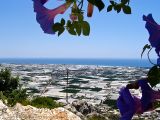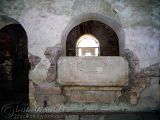Demre - Home of St. Nicholas (original) (raw)
Demre is officially called and signposted as Kale, which is rather confusing since the nearby village of Simena was formerly also known as Kale. Kale-Demre is an expanding modern town amidst a sea of tomato-growing greenhouses. Şahin tepesi (Falcon Hill) is an excellent location for a breathtaking panoramic view on these greenhouses.
History of Demre
In Roman times Demre was called Myra and in the 5th century CE, Myra was the capital of the province of Lycia.
Being the most important city of Lycia, Myra had its own bishop and in the 4th century CE, this was Saint Nicholas. Nicholas was born in about 300 CE in nearby Patara as the son of a wealthy merchant. Upon the death of his father, Nicholas spent his inheritance to help the poor and needy. One of his deeds was to give anonymous gifts to dowryless village girls. To do that, he dropped bags of coins down the chimneys of their houses. This gift from heaven allowed them to marry.
After his death St. Nicholas became the patron saint of Greece, Russia, sailors, children, prisoners, pawnbrokers, unmarried girls, etc. Even towns and cities were named after him: Agios Nikolaos (Greece) and Sint-Niklaas (Belgium) to name a few. He became extremely popular in the Lower Countries (Belgium and the Netherlands) for filling the children's clogs with presents on December 6. In Dutch, his name became corrupted to Sinterklaas, which eventually led to Santa Claus. The Americans eventually merged the good saint with the pagan Father Christmas. This is also the reason why Saint Nicholas is known in Turkish as Baba Noel. More on Saint Nicholas can be found at the Saint Nicholas Center.
Sights and Photos of Demre
St. Nicholas' tomb at Demre became a place of Christian worship and pilgrimage. A chapel was placed over the tomb, which later was replaced by a larger church. The church was reconstructed several times during history, the contemporary version is the result of a restoration sponsored by Tsar Nicholas I of Russia in 1862. The most typical Byzantine feature of the church is the synthronon or bishop's throne in the apsis. During the tourist season, the church and surroundings in Demre become flocked with Russian tourists.
Click on the thumbnails to see greater pictures.
Travel Information and Travel Tips
We visited Demre in 2005 and stayed for two nights in Hotel Kıyak, excellent service, clean rooms. The manager also was very helpful in arranging transportation for our excursions. Demre, combined with the ruins of Myra can be visited on 2-3 hours.












